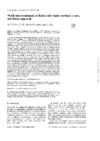Please use this identifier to cite or link to this item:
https://accedacris.ulpgc.es/jspui/handle/10553/743
| Title: | Stock and recruitment in Baltic cod Gadus morhua : a new, non-linear approach | Authors: | Martín-González, J.M. Solari, Aldo Pier Bas Peired,Carlos |
UNESCO Clasification: | 240210 Biología de poblaciones 510208 Pesca |
Keywords: | Peces Poblaciones Modelos matemáticos |
Issue Date: | 1997 | Publisher: | 1054-3139 | Journal: | ICES Journal of Marine Science | Conference: | Mini-Symposium on Arctic Oceanographic Processes - 1995, at the 1995 ICES Annual Science Conference | Abstract: | The stock and recruitment (SR) relationship in Baltic cod is studied. In light of the field data, the authors suggest that the SR relationship oscillates at two levels of stability (cycles) due to the interaction between density-dependent compensation and depensation. Furthermore, density-independent transitions between equilibrium states are assumed due to fishing mortality and medium and long-term periodicities in the abiotic environment which may induce compensatory and depensatory effects upon stock and recruitment. These mechanics are related to concepts such as variable carrying capacity, multiple equilibria, minimum viable population and inverse density dependence. Carrying capacity is regarded as a critical threshold between different equilibrium states and the minimum viable population as an unstable equilibrium below which the SR relationship may not rehabilitate. A modelling approach is put forward where the SR-relationship is regarded as a system or summation of non-linear functions with dynamic features ranging from chaos (the ceiling, when external conditions are extremely benign), going through a range of relatively stable, converging cycles (as external stress increases), to a quasi-standstill state with no clear oscillations (when the minimum viable population is being approached) which may lead to inverse density-dependence (depensatory dynamics). This SR-system is considered as highly flexible as it has the capacity to, persistently, evolve and return within a range of equilibrium states. Also, it is proposed that the SR relationship is, al the present time, nearby the minimum Viable population due to the combined effects from high fishing mortality and negative effects from external perturbations. However, a SR rehabilitation towards a low equilibrium state is expected, during the coming years likely due to positive trends in external perturbations. A simple numerical simulation is put forward where the SR system is perturbed by a sinusoidal external variable at three constant levels of mortality. (C) 1997 International Council for the Exploration of the Sea. | URI: | https://accedacris.ulpgc.es/handle/10553/743 | ISSN: | 1054-3139 | DOI: | 10.1006/jmsc.1996.0193 | Source: | ICES Journal of Marine Science [ISSN 1054-3139], v. 54, p. 427-443 |
| Appears in Collections: | Actas de congresos |
Items in accedaCRIS are protected by copyright, with all rights reserved, unless otherwise indicated.
